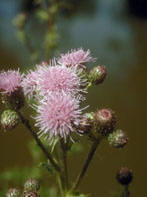Kirsten S. Traynor
Frederick County Master Gardener Program
|

Canada thistle
Cirsium arvense
|
Since people started gardening, they have transplanted plants they admired into new places. Some of those plants adapted well to their new habitat. Unfortunately, a few adapted too well — in their new home these non-native plants are able to spread
rapidly, becoming exotic invasives that choke out native flora.
While many people realize multiflora rose, kudzu and Canada thistle are invasive, they may not recognize the danger of some plants available in garden centers and nurseries.
|

Butterfly bush
Buddleja spp. L |
Butterfly bush (Buddleia davidii), the centerpiece of many butterfly gardens, is a serious problem in New Zealand and the United Kingdom. It is also causing some havoc in America in states such as Washington and Oregon. In those regions it has been
found growing up to 10 feet high from a crack in the side-walk and outcompeting Douglas fir seedlings in reforestation efforts far removed from any home garden.
If you already have a butter-fly bush in your garden, you need not race to the garden shed to pull out your largest pruners. Just keep an eye on your flowering beauty and tend to it. If you want to be extra vigilant, don't let it go to seed. If you
absolutely must have one blooming in your garden, look for cultivated varieties, not the straight species. Be aware research is still being conducted into cultivated varieties.
|

Bradford pear
Pyrus calleryana
|
Another misplaced beauty that transforms the drive along I-270 into a magnificent display of white blossoms in the spring is the beloved Bradford pear (Pyrus calleryana). All those wonderful white flowering trees were not planted by a beautification
board. So how did they come to be there?
The Bradford pear came into existence when the U.S. Department of Agriculture was looking to improve the rootstock of our commercial pear trees. They imported over one hundred pounds of Pyrus calleryana seed into the United States in 1918. From among
this seed stock the Bradford pear was developed, a marvelous, fast growing and elegantly shaped tree with the added benefit that it was self-sterile and so did not produce fruit.
But things were too good to be true. The Bradford pear had one huge shortcoming: Branches form a narrow crotch with the trunk, making them extremely weak. After approximately 20 years of growth, just as a Brad-ford pear starts to reach its greatest
splendor, it easily breaks apart in a thunderstorm or from a coating of ice.
To improve the Bradford pear tree and rectify this problem, a series of new callery pear trees Were developed and introduced that did not suffer from this narrow crotch problem. Suddenly, the self-sterile Bradford pear was not alone! Now it could
cross-pollinate with all these new callery pear trees. This previously "sterile" tree now started to produce fruit. While very small in size, the quantity of fruits made up for any lack in girth. It is these fruits, probably eaten by birds, which caused the tremendous
spread of hybrid callery pears sprouting on every hillside.
|

Tree of Heaven
Ailanthus altissima
|
A second tree weed management programs all over the United States battle is the inappropriately named tree of heaven (Ailanthus altissima). This tree, often incorrectly referred to as stinking sumac, grows along highways, in disturbed areas, in the
rocky outcroppings of fields and anywhere else its prolific seeds seem to land.
Tree of heaven was originally introduced from China as an ornamental tree. You might know it from 'A Tree Grows in Brooklyn." It certainly flourishes in city landscapes. I have even seen it growing two stories up on the side of a stone building and
in a neglected gutter. This tree is easy to spot come winter when the leaves have all fallen. It has a smooth, gray bark with little white markings. As a seedling, it grows almost straight up with one or two branches also growing upward. One of the most recognizable
features is the smooth, red brown bark of its branches.
Often there will be one or two larger trees surrounded by a legion of these straight and erect seedlings. If you happen to see this tree on your property, do not cut it down. When this tree is cut down, it goes into self-protection mode, sending out
dozens of shoots that can sprout up quite a distance away, it seems as far as 50 feet. It will also resprout from the stump.
I try to avoid using chemical means whenever possible, but sadly the only realistic means to deal with tree of heaven is with herbicides. Your local county weed management program can give you detailed information on how to combat this pesky plant
using a simple method called "hack and squirt."
Two Web sites that provide more information are www.nps. gov/plants/alien/fact/aiall.htm and www.naturalresources.umd. edu/Pages/Tree_of_heaven.htm.
For more information on escaped ornamentals and possible native plant replacements, a good resource is the Maryland Native Plant Society Web site: www.mdflora.org.
Read other articles on ecological gardening & native plants
Read other articles by Kirsten Traynor